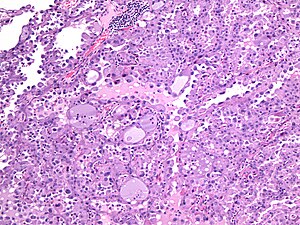Difference between revisions of "Secretory carcinoma of the salivary gland"
Jump to navigation
Jump to search
m (Michael moved page Mammary analogue secretory carcinoma to Secretory carcinoma of the salivary gland: renamed) |
|||
| Line 3: | Line 3: | ||
| Image = Mammary analogue secretory carcinoma (H&E, medium power).jpg | | Image = Mammary analogue secretory carcinoma (H&E, medium power).jpg | ||
| Width = | | Width = | ||
| Caption = | | Caption = Secretory carcinoma of the salivary gland. [[H&E stain]]. (WC/NormanDy) | ||
| Synonyms = | | Synonyms = Mammary analogue secretory carcinoma (previous name) | ||
| Micro = large cells with abundant cytoplasm, small nuclei, +/-lymphocytic infiltrate, solid and microcystic growth pattern | | Micro = large cells with abundant cytoplasm, small nuclei, +/-lymphocytic infiltrate, solid and microcystic growth pattern | ||
| Subtypes = | | Subtypes = | ||
| Line 28: | Line 28: | ||
| Other = | | Other = | ||
| ClinDDx = other [[salivary gland]] tumours | | ClinDDx = other [[salivary gland]] tumours | ||
| Tx = | | Tx = excision | ||
}} | }} | ||
''' | '''Secretory carcinoma of the salivary gland''' is rare a newly described [[malignant]] [[salivary gland]] tumour.<ref name=pmid22127547>{{Cite journal | last1 = Lei | first1 = Y. | last2 = Chiosea | first2 = SI. | title = Re-evaluating historic cohort of salivary acinic cell carcinoma with new diagnostic tools. | journal = Head Neck Pathol | volume = 6 | issue = 2 | pages = 166-70 | month = Jun | year = 2012 | doi = 10.1007/s12105-011-0312-9 | PMID = 22127547 }}</ref> | ||
It was previously known as '''mammary analogue secretory carcinoma''', abbreviated '''MASC'''.<ref name=pmid31007960>{{cite journal |vauthors=Montalvo N, Galarza D, Redrobán L |title=Secretory Carcinoma of the Parotid: Making the Correct Diagnosis of a Rare Salivary Gland Carcinoma When Molecular Biology Testing Is Not Available |journal=Case Rep Pathol |volume=2019 |issue= |pages=5103496 |date=2019 |pmid=31007960 |pmc=6441535 |doi=10.1155/2019/5103496 |url=}}</ref> | |||
==General== | ==General== | ||
Revision as of 15:12, 31 December 2019
| Secretory carcinoma of the salivary gland | |
|---|---|
| Diagnosis in short | |
 Secretory carcinoma of the salivary gland. H&E stain. (WC/NormanDy) | |
|
| |
| Synonyms | Mammary analogue secretory carcinoma (previous name) |
|
| |
| LM | large cells with abundant cytoplasm, small nuclei, +/-lymphocytic infiltrate, solid and microcystic growth pattern |
| LM DDx | acinic cell carcinoma, mucoepidermoid carcinoma |
| Stains | PAS +ve |
| IHC | S-100 +ve, mammaglobin +ve, vimentin +ve |
| Molecular | ETV6-NTRK3 fusion gene |
| Site | salivary gland - usually parotid |
|
| |
| Prevalence | rare |
| Clin. DDx | other salivary gland tumours |
| Treatment | excision |
Secretory carcinoma of the salivary gland is rare a newly described malignant salivary gland tumour.[1]
It was previously known as mammary analogue secretory carcinoma, abbreviated MASC.[2]
General
- Microscopic appearance similar to secretory breast carcinoma.[3]
- Rare - 21 cases in the world literature as of 2012.[1]
- Original paper described it only in adults.[3]
- Has been described in a pediatric patient.[4]
Gross
- Usually parotid gland.[3]
- Well-circumscribed.[citation needed]
Microscopic
Features:
- Large cells with abundant cytoplasm.
- Small nuclei.
- +/-Lymphocytic infiltrate.
- Solid and microcystic growth pattern.
- +/-Cystic changes lined by hobnail cells - useful feature.
DDx:
- Acinic cell carcinoma - very closely mimics.
- Abundant basophilic granular cytoplasm.[1]
- Mucoepidermoid carcinoma.
Images
www:
Stains
Features:[3]
- PAS stain +ve - secretory material.
- Does not have PAS +ve cytoplasmic granules like AcCC.
- Secretory material also PASD stain +ve.
- Mucicarmine stain +ve.
IHC
Features:[3]
Others:
Panel:
- S-100, mammaglobin, p63, HMWCK.
Images
Molecular
Note:
- The translocation seen in secretory breast carcinoma, congenital-infantile fibrosarcoma and mesoblastic nephroma.
See also
References
- ↑ 1.0 1.1 1.2 1.3 1.4 1.5 1.6 Lei, Y.; Chiosea, SI. (Jun 2012). "Re-evaluating historic cohort of salivary acinic cell carcinoma with new diagnostic tools.". Head Neck Pathol 6 (2): 166-70. doi:10.1007/s12105-011-0312-9. PMID 22127547.
- ↑ "Secretory Carcinoma of the Parotid: Making the Correct Diagnosis of a Rare Salivary Gland Carcinoma When Molecular Biology Testing Is Not Available". Case Rep Pathol 2019: 5103496. 2019. doi:10.1155/2019/5103496. PMC 6441535. PMID 31007960. https://www.ncbi.nlm.nih.gov/pmc/articles/PMC6441535/.
- ↑ 3.0 3.1 3.2 3.3 3.4 Skálová, A.; Vanecek, T.; Sima, R.; Laco, J.; Weinreb, I.; Perez-Ordonez, B.; Starek, I.; Geierova, M. et al. (May 2010). "Mammary analogue secretory carcinoma of salivary glands, containing the ETV6-NTRK3 fusion gene: a hitherto undescribed salivary gland tumor entity.". Am J Surg Pathol 34 (5): 599-608. doi:10.1097/PAS.0b013e3181d9efcc. PMID 20410810.
- ↑ Rastatter, JC.; Jatana, KR.; Jennings, LJ.; Melin-Aldana, H. (Mar 2012). "Mammary analogue secretory carcinoma of the parotid gland in a pediatric patient.". Otolaryngol Head Neck Surg 146 (3): 514-5. doi:10.1177/0194599811419044. PMID 21873597.





